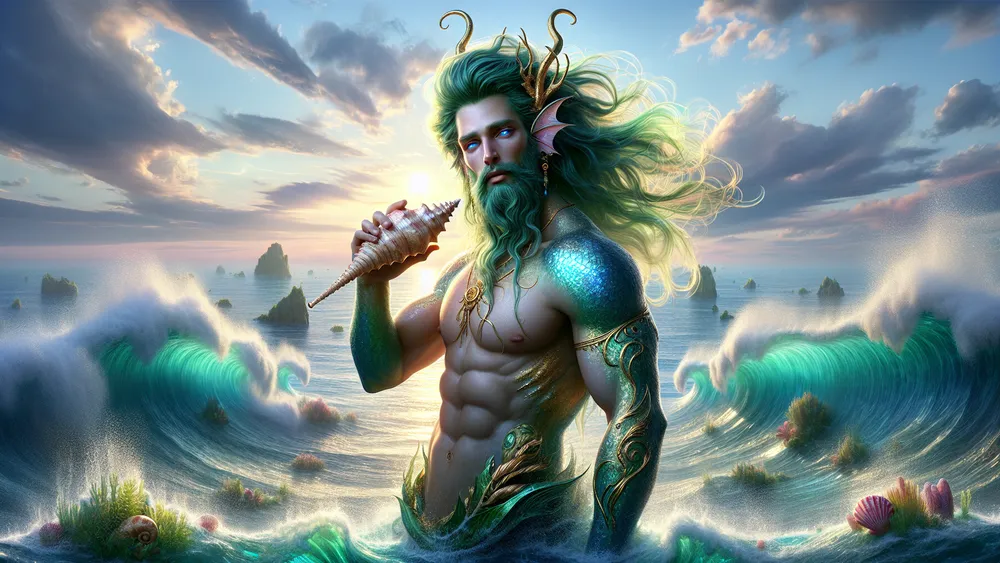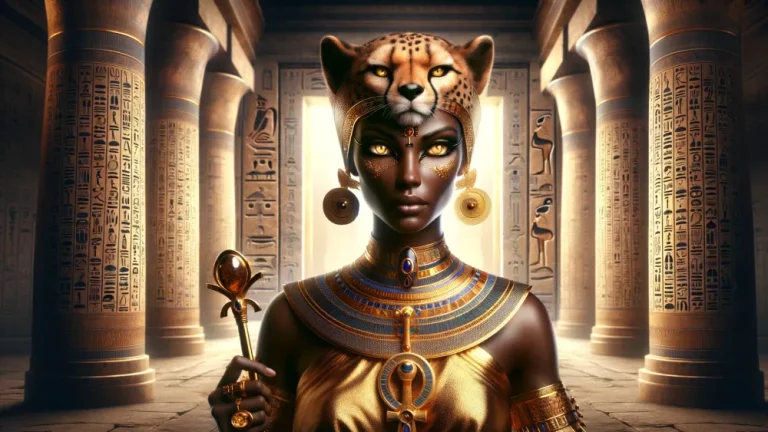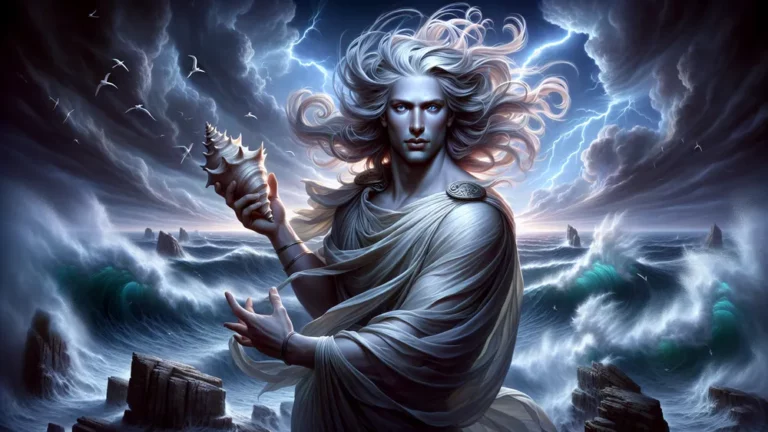Triton: Greek Sea God Of Waves And Calm Seas
Welcome to our look into Triton, the Greek sea god known for his control over sea waves and calm waters. Think of a lifeguard, not only watching the beach but also having the power to control the ocean itself – this is Triton in the realm of Greek mythology. Son of Poseidon, the sea’s god, and Amphitrite, a sea goddess, Triton holds a unique spot in the world of Greek gods.
Key Points:
- Triton is the Greek sea god of waves and calm seas.
- He is the son of Poseidon and Amphitrite.
- Triton is often shown in art as a merman with a conch shell and trident.
- His main roles include delivering messages for Poseidon and controlling the sea.
- Triton appears in various ancient texts like Homer’s Iliad and Virgil’s Aeneid.
- Notable myths involving Triton include guiding the Argonauts and his unrequited love for Scylla.
Throughout this piece, we jump into Triton’s beginnings, his family setup, and his show in old art. There are exciting stories like his guiding the Argonauts and his love for Scylla that wasn’t returned. We also look at his jobs and tasks, such as being Poseidon’s message guy and his skill to command the sea.
By looking at mentions of Triton in old writings like Homer’s “Iliad” and Virgil’s “Aeneid”, we find out more about Triton’s place in ancient tales. Thus, start we do this trip to see more of many parts of Triton, the mysterious sea god who rules both sea’s anger and peace.
Triton: Overview and Key Facts
| Key Point | Description |
|---|---|
| Name | Triton |
| Role | Greek sea god who handles waves and peaceful waters |
| Parents | Poseidon (sea’s god) and Amphitrite (goddess of the sea) |
| Symbols | Conch shell, trident |
| Shown in Art | Often as a merman, with man’s torso and fish’s tail |
| Main Jobs | Poseidon’s message guy, one who controls the sea |
| Talked About | Guiding Argo’s crew, raising Athena, loving Scylla without return |
| Mentions in Old Books | Homer’s “Iliad,” Hesiod’s “Theogony,” Virgil’s “Aeneid,” Apollodorus’ “Bibliotheca” |
| Family Members | Siblings include Rhode and Benthesikyme |
| Influence on Cultures | Influenced Greek and Roman mythology, shown often in old art |
Where Triton Comes From
In understanding Triton’s roots and where he fits in Greek mythology, we have to dig into his family setup and dynamics.
Who Triton’s Parents Are and How He Was Born
Triton’s parents are Poseidon, the strong god of the sea, and Amphitrite, a respected sea goddess. Over the aquatic realms, Poseidon ruled, often shown holding a trident while Amphitrite, known for her grace and beauty, was among the Nereids, or sea nymphs. When they came together, Triton was born, inheriting the divine traits of both his parents. This lineage matters in Greek mythology because it places Triton among top gods, giving him power over the seas. Simply put, think of a child born to royalty destined for power and influence – this is where Triton stands in mythology. Some key points about his parents include:
- Poseidon: God of the sea, quakes, and horses; brother to Zeus and Hades.
- Amphitrite: Sea goddess and one of the Nereids; known for her beauty and grace.
Triton’s lineage from Poseidon and Amphitrite grants him power over the seas, positioning him as a prominent figure in Greek mythology.
Triton’s Brothers, Sisters, and Family Life
Triton had many brothers and sisters, each important in Greek mythology. Regarding the siblings: Rhode became the goddess of the island of Rhodes, and Benthesikyme, she lived in the depths of the sea. Within Poseidon’s household, the family relationships were complex, similar to any diverse family with different roles and tasks. Poseidon, the head, had immense power while Amphitrite provided a caring presence. They had their own areas and duties, making sure the ocean’s ecosystem was balanced. Furthermore, Poseidon’s family can be seen as a team, each member playing their part for a smooth underwater world. Some important points about Triton’s siblings include:

- Rhode: Goddess of the island of Rhodes.
- Benthesikyme: She lived in the depths of the sea.
- Other Siblings: Other minor deities and sea creatures connected with Poseidon and Amphitrite.
How People Portray Triton
Considering his origins and family, we should look at the way he is shown in art and literature over time.
How Triton Was Shown in Art
In ancient art, Triton is often shown as a merman, with the torso of a man and the tail of a fish, which shows his control over the sea. Many sculptures of him show a strong body, focusing on his strength and divine nature. Paintings and mosaics from Greece and Rome show Triton in different stances. Sometimes he blows a conch shell or rides sea creatures.
This shows him as a strong and important figure of the ocean. He is important.
Triton has symbols. The conch shell and trident are part of him. In his hand or when he blows the conch, it shows he can control the waves and make the sea calm. A trident, which is a three-pronged spear, shows his power, like his father, Poseidon. These symbols are like a doctor’s stethoscope or a firefighter’s helmet, which show their jobs. Some important symbols related to Triton include:
- Conch Shell: Shows his power to control the sea and talk to sea creatures.
- Trident: Shows his power and connection to Poseidon.
Triton’s Image in Greek and Roman Art
In the Hellenistic period, Triton’s look became more detailed and lively, which show the era’s focus on movement and emotion. Many sculptures of him showed Triton in more dramatic poses, showing his connection to the sea’s strength. As we move into the Roman period, Triton’s image changed more. It became more standard and often appeared in large mosaics and frescoes that decorated public baths and homes.

Notable artworks from this time are the detailed mosaics of the Baths of Neptune in Ostia, which show Triton beside other sea gods, showing his importance. It changes. This change is like how modern characters fit different tastes in art styles, keeping them important in different times.
Stories and Legends About Triton
After we look at Triton’s shows, we should talk about the many stories and myths and legends that feature this interesting sea god.
Triton and the Argonauts: Guiding the Way
In one of the most interesting stories with Triton, he has an essential role in helping the Argonauts, a group led by Jason, go through dangerous waters. After they got the Golden Fleece, the Argonauts got lost in the Libyan desert, far from the sea. Triton appeared to help, giving them a clod of earth as a sign.
He guided them to the Tritonian Lake so they could find their way back to the Mediterranean Sea. This divine act shows Triton’s job as a helper and guide, like a detailed map helps travelers in unknown places.
This story is very important in Greek myths. It shows how gods help people in hard times. Triton’s help shows gods’ readiness to assist humans, showing the close link between gods and humans. This myth also shows trust in gods. The Argonauts trusted Triton to help them. Key points about this myth are:
- Divine Intervention: Shows gods’ active help in human lives.
- Guidance and Protection: Shows Triton helping sailors and travelers.
- Interconnectedness: Shows the close link between gods and humans in Greek stories.
Triton’s role in guiding the Argonauts through perilous waters demonstrates the close connection between gods and humans in Greek mythology, emphasizing divine assistance, guidance, and trust.
Triton and Athena: Raising the Goddess of Wisdom
In a lesser-known but interesting story, Triton had a vital role in raising Athena, the goddess of wisdom. Zeus gave Athena to Triton to care for and teach. Triton raised her with his own daughter, Pallas, and they became close friends. This relationship between Triton and Athena shows Triton’s job as a teacher and protector. He was wise.
This act highlights Triton’s care and respected place among the gods. This story adds to Triton’s character, showing the close bonds and respect among the gods in Greek mythology.
Triton and Scylla: Love That Didn’t Happen
In the sad story of Triton and Scylla, we see a tale of one-sided love and sadness. Triton, the strong sea god, fell in love with Scylla. Despite his efforts to win her heart, she did not care. She stayed uninterested. This story looks at love and people not being loved back, showing the pain of one-sided feelings, which is still relevant today.
As is seen today, Triton’s one-sided love for Scylla shows how even powerful beings can feel emotions deeply. This story shows Triton’s emotions, proving that even gods feel the complexities of love and rejection.
What Triton Does
After we looked into the stories about Triton, we should now think about his jobs within the sea area.
Triton as Poseidon’s Messenger
Triton is Poseidon’s son and his main messenger in the big ocean area. Similar to how a diplomat or enforcer works today, Triton gives Poseidon’s orders to other sea gods and creatures, making sure his father’s will is carried out all over the water. He has to calm the seas when there are storms, help sailors get to safety, and also sometimes punish those who do not follow Poseidon’s rules. Triton’s jobs are very important for keeping things in order under the sea, and he is often shown blowing a conch shell to let others know he has arrived. Key points about Triton’s jobs:
- Delivering Messages: He gives Poseidon’s orders to other sea beings.
- Enforcing Poseidon’s Will: He makes sure the sea follows Poseidon’s rules and punishes those who do not.
- Calming the Seas: He uses his powers to make rough waters calm and keep sailors safe.
How Triton Controls the Sea
Triton has a lot of control over the sea. He uses his skills to manage waves and calm rough waters. Similar to how a person directs, Triton is able to call and quiet down the ocean’s power with precision. One of his main tools is the conch shell. He blows it to either raise or calm the waves. For example, in the story of the Argonauts, he guides the heroes safely through dangerous waters by using his conch shell, showing his ability to control the sea for safety and navigation. In another case, Triton calms a stormy sea so sailors can reach their destination safely. Key points about Triton’s control over the sea include:

- Using the Conch Shell: He blows the conch shell to command the waves.
- Guiding Sailors: He helps sailors by calming the seas and giving safe passage.
- Pacifying Storms: He calms rough waters to stop disasters.
Triton in Old Texts
After looking at Triton’s roles and powers, we should now look into how ancient texts have shown this interesting sea god.
Mentions of Triton in Homer’s Iliad
In Homer’s ‘Iliad’, Triton is mentioned briefly, but when he shows up, it has a big impact in the story. Even though he is not a central character, Triton’s appearances are like special appearances adding depth to the story. His main job is to show how the gods affect human lives, especially related to the sea and its dangers.
For instance, when the gods talk about the fate of the Greek and Trojan warriors, Triton’s name comes up to remind people of the power of sea gods. These mentions connect the gods with human events, showing the importance of the gods in ancient Greek life.

Triton’s Role in Hesiod’s Theogony
In Hesiod’s ‘Theogony’, Triton is shown as a vital part of the sea gods, mainly through his family line as Poseidon’s and Amphitrite’s son. This epic poem, a genealogy of the gods, shows Triton is key in the ocean’s divine structure. His job shows he matters in keeping the sea’s order. It’s not only his tasks; they also stand for the power and reach of Poseidon’s domain.
Being in this text sets Triton as an essential and powerful sea god, and it reinforces his standing and impact in Greek mythology.
Triton in Virgil’s Aeneid
In Virgil’s ‘Aeneid’, Triton shows up in ways that highlight his role as a strong sea god. His appearance is important during the trip of Aeneas, where he is a guardian and guide, helping the Trojan hero and his fleet have a safe trip. Notably, Triton’s role is crucial in navigating dangers of the sea.
For example, when Aeneas and his men face a strong storm, Triton helps calm the water, letting them keep going. These actions show Triton’s control over the sea and his important place among the gods, showing he protects and enforces Poseidon’s will.
How Apollodorus Talks About Triton in Bibliotheca
In Apollodorus’ ‘Bibliotheca’, Triton is shown as a strong and many-sided sea god, adding a lot to his story. Apollodorus shows Triton not just as Poseidon’s son, but active in many myths, similar to an essential character in a big family story. For example, Triton helps heroes and gods regularly, showing he is a key link between gods and humans.
This shows more about Triton, showing he matters beyond just being Poseidon’s son. By talking about his actions and jobs, Apollodorus helps us know Triton better, showing him as a vital and strong figure in Greek stories.
Pantheon of Greek Mythology Gods
The group of Greek mythology gods is a vast and complex mix of gods, each with their own stories, traits, and areas. You have the main Olympian gods like Zeus, Hera, and Poseidon and many lesser-known gods and spirits. This group of gods covers every part of the natural and supernatural world.
To understand this group of gods and learn about each god’s role and importance, refer to this list of all the Greek gods. This list gives detailed information on the many gods and goddesses in Greek mythology, and it helps you understand their relationships and influence.
FAQs
1. Who are Triton’s parents?
Triton’s parents are Poseidon, the god of the sea, and Amphitrite, a sea goddess.
2. What are Triton’s main symbols?
Triton’s main symbols are the conch shell and the trident.
3. How is Triton depicted in ancient art?
Triton is depicted in ancient art as a merman with the torso of a man and the tail of a fish, often holding a conch shell or trident.
4. What myths involve Triton?
Myths that involve Triton include his guidance of the Argonauts, his relationship with Athena, and his unrequited love for Scylla.







